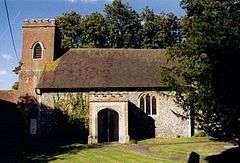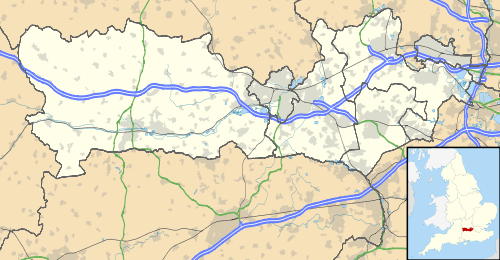Frilsham
Frilsham is a village and civil parish centred 4 miles (6.4 km) NE of Newbury, in the English county of Berkshire. It is a village near the Berkshire Downs, bisected by the M4 in its north and its nucleus is on a hill surrounded by woods and meadows. Various roads and buildings have views over the small valley formed by the upper Pang (or Pang Bourne).
| Frilsham | |
|---|---|
 St Frideswide Church, Frilsham | |
 Frilsham Location within Berkshire | |
| Area | 4.91 km2 (1.90 sq mi) |
| Population | 315 (2011 census)[1] |
| • Density | 64/km2 (170/sq mi) |
| Civil parish |
|
| Unitary authority | |
| Ceremonial county | |
| Region | |
| Country | England |
| Sovereign state | United Kingdom |
| Post town | Thatcham |
| Postcode district | RG18 |
| Police | Thames Valley |
| Fire | Royal Berkshire |
| Ambulance | South Central |
| UK Parliament | |
Geography
It is a village near the Berkshire Downs, bisected by the M4 in its north and its nucleus is on a hill surrounded by woods and meadows. One of the woods, Coombe Wood is listed as a site of Site of Special Scientific Interest (SSSI).[2] Various roads and buildings have views over the small valley formed by the upper Pang (or Pang Bourne).
No mill is mentioned in the Domesday Brook, nor does any record of one occur until 1839. It was then stated that in 1838 the springs were so low that no water passed the mill for several months, and mention was made of a tradition that about 100 years earlier the springs were equally low and that a duck had then made her nest under the water-wheel, laid her eggs and hatched a brood before a drop of water had passed.
History
Economic history
The chief crops were in the 1920s wheat, barley and oats. The soil is chalk near the river, but there are beds of clay and sand at the eastern side of the parish. No railway or canal passes through the parish, with one well-maintained road from north to south from Hampstead Norris to Bucklebury. Frilsham Common was inclosed in 1857. The population was at that time purely agricultural. The village was round the church at the southern end of the parish, with the rectory to the east. Aside from the varied elevations an aesthetic point made was of chestnut trees in the north of the church yard by gazetteer compilers in the 1920s.[3]
Manor
The manor was held of Edward the Confessor by two free men, two decades later on the Domesday Survey it was owned by Henry de Ferrers. His son was elevated to an earl, Earl Ferrers, and the overlordship continued in the hands of his descendants until the 13th century, it is recorded as held of the fee of the Earl of Derby's eldest son, Earl Ferrers. Double-incidence rebel Robert de Ferrers, 6th Earl of Derby led an insurrection in 1263 and was three years later deprived of his earldom of Derby and estates, which were then granted to Edmund Crouchback, the king's son. In consequence this overlordship followed the descent of the earldom and duchy of Lancaster. Manorial court rolls for the year 1440–1 are in the archives of the Duchy.[3]
Its various tenants include the related families of Sir Ralph Peche such as in 1173; Walter de Rideware, in the 13th century, Sir Oliver d'Eincourt, Walter de Rideware, Sir Thomas Rideware, John Falconer of Thurcaston, and William Cotton.[3]
From 1372 this descent included: Hugh de Berwyk, Ralph Boteler, William Haute, John Boteler, then by sale: Sir Edmund Hungerford, kt., and others purchasing land in this neighbourhood for John Norreys – see Hampstead Norreys.[3]
He was the eldest son of William Norreys of Bray. His later namesake seems to have attached to his adjoining manor of Yattendon with which manor it afterwards passed until 1623, when, on the death of the Earl of Berkshire, Frilsham passed to his daughter Elizabeth wife of Edward Wray. It passed to second husband the Earl of Lindsey then James Bertie, her eldest son by her second husband, was in 1675 created Baron Norreys of Rycote and in 1682 Earl of Abingdon. It remained in this line of earls until sold to 'Sir George Cornewall', born Sir George Amyand a leading Whig of London. In 1800 Sir George sold this manor to Mr. Hayward who left it to relation Robert Floyd on his 1818 death. His family long after were the official patrons of the parish church.[4]
His daughter-in-law sold it in 1903 to Henry Frederick George Weber, previously of Bucklebury, and sold in 1907 to Sir Cameron Gull, of Frilsham House, the other major home and estate in the parish, who thus enhanced his local monopoly on the parish's agriculture land.[3]
Landmarks
Benjamin Buckler, author (including of Stemmata Chichcleana, past Rector of Frilsham John Bradford, later Nonconformist minister and author of several works on theology, was a curate (minor cleric) at a similar time.[3]
Nearest places
Bucklebury is large in terms of amenities among these, however smaller than most English definitions of a town, however has for instance three churches.
Demography
| Output area | Homes owned outright | Owned with a loan | Socially rented | Privately rented | Other | km² roads | km² water | km² domestic gardens | Usual residents | km² |
|---|---|---|---|---|---|---|---|---|---|---|
| Civil parish | 36 | 40 | 14 | 28 | 9 | 0.163 | 0.021 | 0.166 | 315 | 4.91 |
References
- Key Statistics: Dwellings; Quick Statistics: Population Density; Physical Environment: Land Use Survey 2005
- "Magic Map Application". Magic.defra.gov.uk. Retrieved 6 March 2017.
- William Page; P.H. Ditchfield, eds. (1924). "Parishes: Frilsham". A History of the County of Berkshire: Volume 4. Institute of Historical Research. Retrieved 6 December 2014.
- Imperial Gazetteer of Great Britain 1870-72 John Marius Wilson.